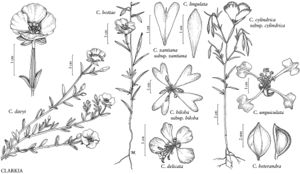Clarkia lingulata
Madroño 12: 35. 1953.
Stems erect, to 60 cm, puberulent. Leaves: petiole to 15 mm; blade linear to narrowly lanceolate, 2–6 cm. Inflorescences open racemes, axis recurved at tip in bud; buds pendent. Flowers: floral-tube 1–4 mm; sepals reflexed together to 1 side; corolla rotate, petals bright pink, red-flecked or not, oblanceolate, 10–20 mm, apex subentire or minutely notched; stamens 8, unequal, outer anthers lavender, inner smaller, paler. Capsules 10–20 mm. Seeds brown, 1 mm, minutely scaly to puberulent, crest inconspicuous. 2n = 18.
Phenology: Flowering May–Jun.
Habitat: Open chaparral.
Elevation: 400–500 m.
Discussion
Clarkia lingulata is listed as endangered by the State of California, known from only a few populations in Merced River Canyon, Mariposa County. It is derived from C. biloba subsp. australis, from which it can be distinguished morphologically by its narrower, unlobed petals; the two taxa also differ in chromosome number, and form only highly sterile hybrids.
Selected References
None.
